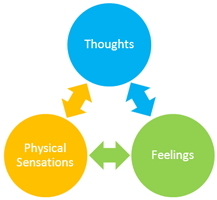As mentioned several modules earlier, emotions give us information and help us respond to events in our environment. Part of the emotional experience is the physical sensations that accompany them. These help us prepare to act quickly. While these are immensely important and helpful when we’re in danger, they can be a problem when we’re experiencing them in the absence of real danger.
|
These physical sensations can have the impact of intensifying your emotional experience and directing how you behave, in the same way that emotions can affect your physical sensations and behaviours. At the end of the day, the important thing is how you interpret the meaning of your physical and emotional reactions. Take the following example: You become aware your heart is beating a little faster than normal and you’re feeling a little light headed. You might start to worry that you’re going to pass out. As you have this thought, you check for other signs that you’re going to pass out. Now you notice that your heart is beating faster, you’re starting to sweat, and you’re feeling dizzy. You’re slowly becoming convinced that you’re going to pass out and you are aware of feeling scared and thinking how embarrassing it would be to pass out in public. Again, your fear steadily increases, as do your physical symptoms. |
|

|
This is a perfect example of how physical sensations influence feelings and thoughts and how these in turn, influence physical sensations. What you may have forgotten, in this instance, was that you had skipped lunch and were feeling the effects of that. Chances are, if you had attributed your feelings of light-headedness to needing to eat, you could have avoided the vicious cycle of anxious reactions that followed. |
